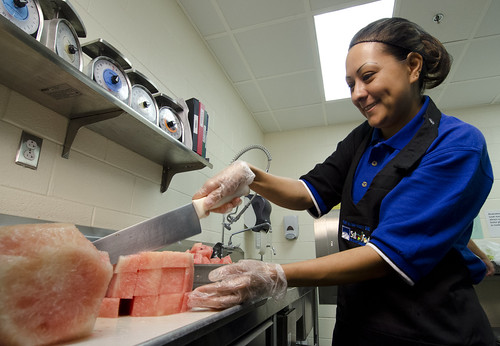
Whether it’s solving a math problem or figuring out how to buy quality fresh apples, having the right tools and training will lead you to a positive solution. Managing fresh and fresh-cut produce purchases can seem like a complicated math problem for many schools, food banks and other large volume institutions. To help them figure out the right formula and address all of the variables, USDA’s Agricultural Marketing Service (AMS) designed a webinar series to help these establishments successfully buy, receive and handle fresh and fresh-cut produce.
The webinar series is an off-shoot of an ongoing AMS produce webinar series and the popular Produce Safety University (PSU), which helps school foodservice personnel identify and manage food safety risks associated with handling fresh produce. While PSU was delivered using interactive, hands-on classes, the webinar series’ online format allows more people to expand their knowledge of all things produce. As a result, more and more large volume institutions will be able to satisfy their demand for fresh produce.
When it comes to dealing with a large volume of perishable produce, there are many factors that must be addressed. For example, not knowing how long it takes lettuce to wilt or the proper temperature to store bags of sliced apples can be a disaster for any food bank. These operations rely on products that have a long shelf-life. Knowing the shelf-life of fresh produce and other food donations is essential to step in helping them feed those in need. The same can be said for buying quality produce at a reasonable price. With a limited budget and wide variety of palettes to satisfy, schools and food banks need to get the biggest bang for their buck.
Our webinar series covers these types of topics and so much more. Our first installment, introduced more than 400 participants to quality and defect issues for produce in addition to giving some storage guidelines. The series will continue on December 18, with a lesson on using our Fruit and Vegetable Market News Portal. Participants will learn how to navigate the customizable reports on the website. The Portal can be used to do things like analyzing price trends to help make an informed decision when buying. Or they can decide how much of a certain produce item might be available based on reports that show how much product has arrived at the local terminal market.
If you buy, receive or handle large volumes of fresh or fresh-cut produce, our webinar series can help you make a winning formula. We recommend that you register for Learn the Language of Produce: How to Use Market News. The series will continue into the new year, so check for updates on the AMS website.


